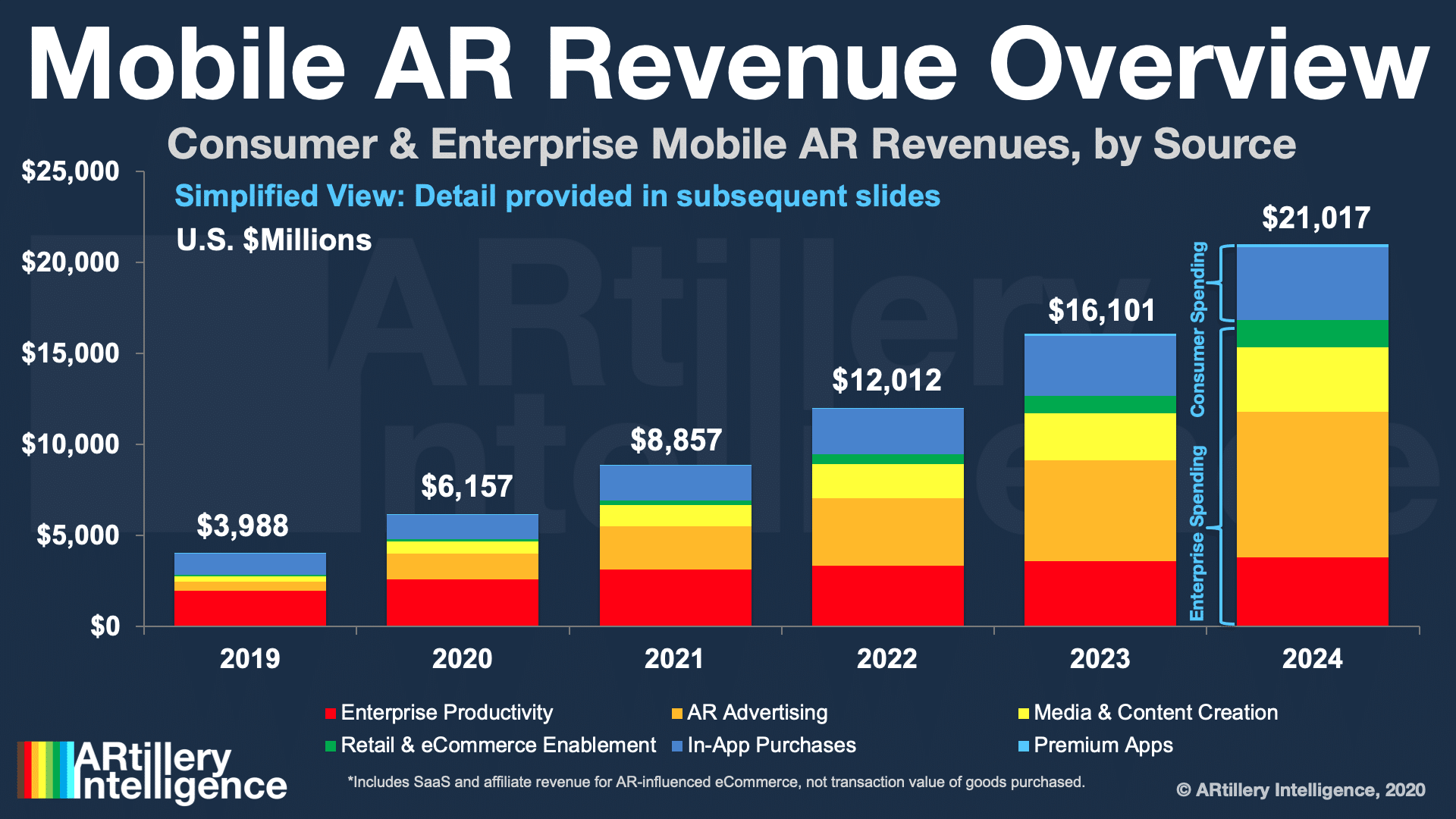
![]() “Behind the Numbers” is AR Insider’s series that examines strategic takeaways from the original data of its research arm, ARtillery Intelligence. Each post drills down on one topic or chart. Subscribe or login to access the full library of data and reports.
“Behind the Numbers” is AR Insider’s series that examines strategic takeaways from the original data of its research arm, ARtillery Intelligence. Each post drills down on one topic or chart. Subscribe or login to access the full library of data and reports.
Like many analyst firms, one of the things that AR Insider’s research arm ARtillery Intelligence does is market sizing. A few times per year, it goes into isolation and buries itself deep in financial modeling. The latest projections zero in smartphone-based AR, which the firm announced yesterday.
This takes the insights and observations accumulated throughout the year and synthesizes them into hard numbers for the spatial computing industry (see methodology and inclusions/exclusions). It’s all about a strong forecast model and lots of rigor in assembling reliable inputs.
So what did the forecast uncover? At a high level, global mobile AR revenue is projected to grow from U.S. $3.98 billion in 2019 to U.S. $21 billion in 2024, a 39 percent CAGR. This sum consists of mobile AR consumer and enterprise spending and their revenue subsegments.

Drilling Down
As for how mobile AR revenues break down, enterprise productivity is projected to hold the leading share by the end of 2020 with $2.58 billion. That’s followed by AR advertising at $1.41 billion and consumer in-app purchases at $1.38 billion. The latter mostly includes Pokémon Go.
As for outer years of the five-year outlook, AR advertising will lead mobile AR revenue with $8.1 billion projected by the end of 2024. This will be driven by continued interest and momentum from brands to demonstrate products in immersive ways, as fueled by ROI signals today.
Subcategories worth noting include enterprise AR productivity, media & content creation, and commerce enablement. These are what we call AR as a Service (ARaaS) — enabling companies to build AR for internal productivity (B2B), or for consumer-facing experiences (B2B2C).
B2B examples include industrial AR visualization in areas like assembly and maintenance. B2B2C examples include software to scale up 3D product models. These “picks & shovels” represent an opportunity to meet the demand for democratized AR creation, and accelerated time to market.
The Foundation
One of the factors driving the above revenues is the sheer size of mobile AR’s installed base of smartphones. Compared to the uphill battle that AR glasses face, mobile AR — though challenged in many of its own ways — has an easier climb as it piggybacks on ubiquitous hardware.
So the question is how many AR-compatible devices are out there? This was previously framed as one monolithic figure that included ARCore and ARkit. But things have since fragmented into several platforms, the largest of which is web AR with 3.04 billion compatible devices.
As for the other platforms on that list, Facebook is projected to have 1.58 billion AR compatible smartphones by the end of this year, followed by ARkit (1.19 billion), TikTok (950 million), ARCore (633 million) and Snapchat (240 million). As always, these figures represent year-end estimates.
The keyword in the above analysis is “compatible,” as it tallies devices that are AR-ready. A more important figure is how many are AR-active. ARtillery Intelligence projects that total at 598 million, growing to 1.73 billion by 2024 as advanced hardware cycles in, and AR acclimates culturally.

Elephant in the Room
The elephant in the room in all of the above is a global pandemic. As is the case across the global economy, mobile AR sectors will be impacted unevenly by ongoing global lockdowns. Given that software mostly fares well in shelter-in-place life, the impact on mobile AR will be mostly positive.
For example, quarantine-friendly consumer AR like social lenses are trending up; and social distancing compels enterprise remote-AR support. These factors will boost near term adoption while exposing the technology… which in-turn supports its longer-term sustained adoption.
Stepping back, ARtillery Intelligence’s position on AR revenue growth is best characterized as cautiously optimistic. Growth and scale will come, but slower than many industry proponents have thought, due partly to the pace of adoption and other signals that ARtillery Intelligence tracks.
Stay tuned for more forecast tidbits and insights over the coming weeks. Meanwhile, find out more about the market-sizing methodology or access the entire thing here. There will be lots to unpack as the AR market unfolds and brings us a combination of expected and unexpected outcomes.
